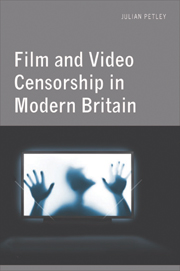Book contents
- Frontmatter
- Contents
- Acknowledgements
- Dedication
- Introduction
- Part I Censorious Rigmarole and Legalistic Overkill
- 1 A Nasty Story
- 2 Nastier Still
- 3 Two or Three Things I Know About ‘Video Nasties’
- Part II After the Deluge
- Part III Nineties Nightmares
- Part IV New Millennium, New Beginning?
- Appendix: The DPP List of ‘Video Nasties’
- Bibliography
- Index
3 - Two or Three Things I Know About ‘Video Nasties’
from Part I - Censorious Rigmarole and Legalistic Overkill
Published online by Cambridge University Press: 05 August 2013
- Frontmatter
- Contents
- Acknowledgements
- Dedication
- Introduction
- Part I Censorious Rigmarole and Legalistic Overkill
- 1 A Nasty Story
- 2 Nastier Still
- 3 Two or Three Things I Know About ‘Video Nasties’
- Part II After the Deluge
- Part III Nineties Nightmares
- Part IV New Millennium, New Beginning?
- Appendix: The DPP List of ‘Video Nasties’
- Bibliography
- Index
Summary
A good deal has been written recently, if somewhat belatedly, about the Video Recordings Act. Amidst all this welter of concern, however, the original objects of debate, the so-called ‘video nasties’, are largely conspicuous by their absence – as has, in fact, been the case all along. In the first articles to appear in the press about horror videos, a certain litany rapidly took shape out of capsule descriptions of half a dozen or so videos. Thus on 28 May 1982, the Daily Mail complains of ‘films which show castration, sadistic attacks on women and violence including the use of chain saws and electric drills’, and on 30 May, The Sunday Times warns of ‘films which specialise in extreme violence, sadism, mutilation and cannibalism’.
With the addition of disembowelling and humiliation, this is the litany which is to be endlessly intoned by the press (and later, parliament) for the next two years. Not until November 1983 is there any real discussion of what a ‘video nasty’ might actually be, and then neither in a film magazine nor by a film specialist: ‘How Nasty Are the Nasties?’, Martin Barker, New Society, 10 November 1983. This is then followed by two pieces by Nigel Andrews in the Financial Times (3 and 10 December). And that's it, until the publication in September 1984 of Martin Barker's excellent collection of essays, The Video Nasties, in which analysis of the films themselves is none the less still limited to a reprint of the Andrews pieces and an expanded version of the New Society article.
- Type
- Chapter
- Information
- Film and Video Censorship in Modern Britain , pp. 44 - 48Publisher: Edinburgh University PressPrint publication year: 2011



